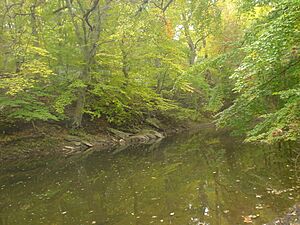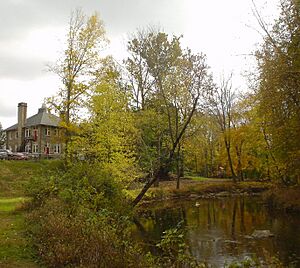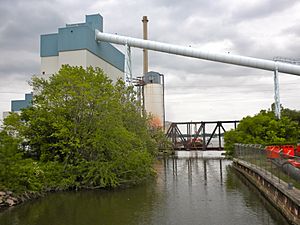Chester Creek facts for kids

Chester Creek is a stream in Delaware County, Pennsylvania. It is about 9.4 miles (15.1 km) long. This creek flows into the Delaware River.
Contents
East Branch Chester Creek
The East Branch of Chester Creek is about 17.1 miles (27.5 km) long. It starts near Kirkland. It flows under major roads like U.S. Route 202 and Pennsylvania Route 100.
Further downstream, the creek is held back by dams to form two reservoirs: the West Chester Reservoir and the Milltown Reservoir. It then flows south through areas like Westtown. Here, another stream called Goose Creek joins it. An old train track, now owned by SEPTA, runs next to this part of the creek.
The East Branch continues south, passing a large stone quarry at Glen Mills. It winds through towns like Darlington and Wawa. Finally, it meets the West Branch at a place called Lenni.
West Branch Chester Creek
The West Branch of Chester Creek is about 9.1 miles (14.6 km) long. It begins near Dillworthtown in Chester County. It flows mostly eastward.
Before it enters Delaware County, a dam forms Brinton Lake. At Markham, Webb Creek flows into it near the historic Newlin Grist Mill. For some distance, an old train path runs alongside the creek. This path was damaged by floods from Hurricane Agnes in 1972.
The creek then makes a big loop through a deep valley near Chester Heights. It eventually turns north to meet the East Branch just below Lenni.
Main Stream
The East and West Branches of Chester Creek come together between Lenni and Glen Riddle. From this point, it becomes the main Chester Creek.
The main stream flows through a rocky valley. In the past, many mills used the creek's power here. A railroad, built in 1869, followed the creek from Lenni to Upland. This rail line was also badly damaged by floods during Hurricane Agnes in 1972.
Chester Creek finally flows into the Delaware River at the Port of Chester in Chester.
History of Chester Creek
The original Native American name for Chester Creek was Meechoppenackhan. This name means "the large potato stream" or "the stream where large potatoes grow."
In 1644, the lower part of the creek's area was used as a tobacco farm. On August 20, 1653, land on the west side of the creek was given to John Ammundson Besk and his family. Swedish settlers were among the first people to live in this area.
A Healthy Ecosystem
Chester Creek is known for being one of the healthiest creeks in Pennsylvania that flows into the Delaware River. Other nearby creeks include Darby, Crum, and Ridley.
The banks of Chester Creek still look very natural, much like they did when William Penn arrived in Pennsylvania in 1681. You can see many large rocks, natural slopes, and native plants along the creek.
Many streams in Pennsylvania used to have Brook Trout. Today, Chester Creek is one of the few places where these fish most likely still live naturally. Also, Freshwater Eels still travel up the river. They have been seen far upstream in both the East and West Branches. These facts show that Chester Creek has a very healthy environment for wildlife.
Tributaries
Tributaries are smaller streams or rivers that flow into a larger one.
East Branch Tributaries
- Goose Creek
- Westtown Run
- Hickman Run
- Forsythe Run
- Rocky Run
West Branch Tributaries
- Green Creek
- Webb Creek
- Deborahs Run
Main Stream Tributaries
- Crum Run
- Chrome Run
- Baldwin Run



